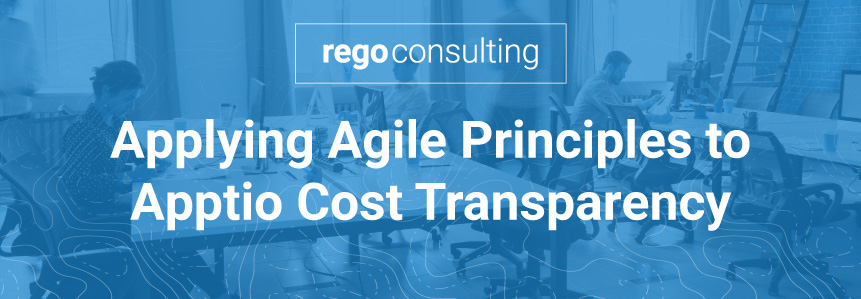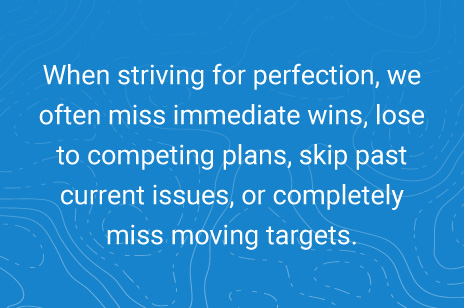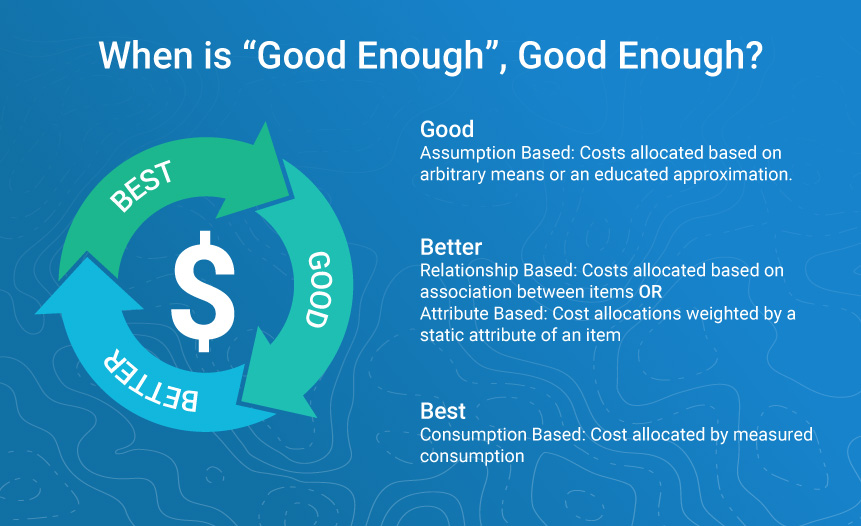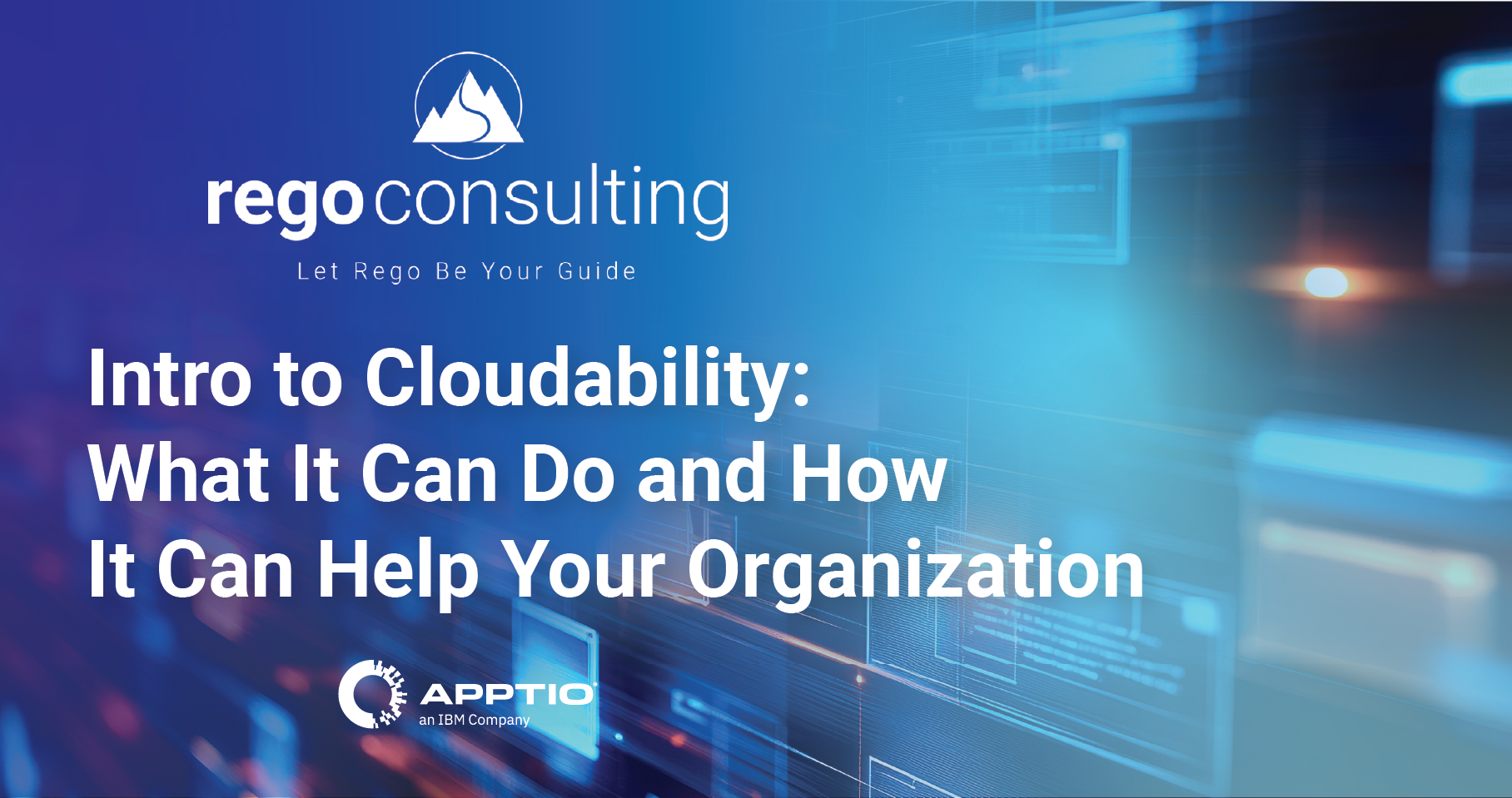
Changing your mindset to realize immediate outcomes for your TBM program
 Perfection being the enemy of good is a concept that reaches back to the 1700s. While a well-aged aphorism, this idea still applies to many facets of business, including Agile principles and cost transparency.
Perfection being the enemy of good is a concept that reaches back to the 1700s. While a well-aged aphorism, this idea still applies to many facets of business, including Agile principles and cost transparency.
When striving for perfection, we often miss immediate wins, lose to competing plans, skip past current issues, or completely miss moving targets. The idea of shooting for “good enough” supports Agile principles and allows you to realize immediate outcomes. Immediate outcomes give you the data needed to plan the best next steps.
Many with an IT or product development background are familiar with the concept of creating parameters for a Minimal Viable Product (MVP). On the other hand, those with an accounting or financial background may be more used to striving for complete accuracy working with complete data sets. For some, working with shorter iterations or incomplete data sets may seem counterintuitive to the point of planning paralysis. This is a form of business “anxiety” or overthinking that may halt or delay productivity.
Cost Transparency: Good Enough vs. Perfection Philosophies
Shifting your mindset to “good enough” to facilitate forward movement helps those involved in monitoring and planning IT expenses. This outlook can help identify immediate areas of concern or previously unidentified efficiencies that can be acted upon now rather than later.
Good vs. perfection is not a new concept, and a handful of philosophies support this principle, such as
The 80/20 Rule
This aphorism, also known as the Pareto Principle, postulates that 80 percent of outcomes result from only 20 percent of the input. Using “good enough” as a starting point in planning, you quickly begin the process of identifying inputs that can produce the most results (outputs).
The Weighted Shortest Job First
The Weighted Shortest Job First (WSJF) model can be applied alongside other concepts to help prioritize work. WSJF uses simple calculations using two metrics, the cost of delay divided and time. The higher the resulting value is considered, the higher the priority. You can use estimated values to help prioritize work using this tool.
Perfect is the Enemy of Good
This core concept is attributed to a saying that is most often credited to Voltaire. In modern terms, it may sound something like, “get yourself out of your own way.” The concept of perfection is limiting because it doesn’t exist in most cases. Additionally, often in business, the target is always moving. If perfection doesn’t exist, you’ll never achieve it. So, therefore, do something right now.
Worse is Better
This is a somewhat controversial new concept that first surfaced in the late 1980s through an essay written by Richard P. Gabriel covering the topic of software acceptance written to turn the tables on the MIT approach of “The Right Thing.” In application to IT planning and cost transparency, the takeaway would be to keep the initial process and implementation simple rather than aiming for “completeness” within the early stages.
Another phrase you can find thrown around the internet is that we don’t know the future yet, so why not start now? Simply begin planning and moving forward based on the data you have today.

Advantages of Implementing “Good Enough” Practices to Achieve Cost Transparency
Using a tool such as Apptio to analyze IT costs provides benefits even if the long-term plans are not entirely outlined or even if the data sets are incomplete. In some ways, it makes sense to think of some reports as tools for decision-making rather than as monitoring tools.
Reports Without Complete Data Sets Still Produce Results
Reports with incomplete data sets can still produce actionable results and lead the way towards cost transparency. For example, using Apptio reporting tools, you may realize you are overspending on IT assets. Perhaps there have been organizational changes, and some IT assets have been retained even though they are no longer being used, or maybe not all the licenses are being actively used. This is something you could investigate right away that you may not have recognized before.
Immediate Use of Apptio Helps Promote Early Adoption
If your Apptio implementation is new, you can ensure better early adoption rates if you use the tools right away. If you can show your team what the software can do, they may immediately begin to test its capabilities and imagine how they could use the platform too. You may benefit from implementation and onboarding professional services to help launch the platform successfully.
Incomplete Reports May Incite Action
Sometimes presenting reports with missing and outdated data may shine a light on team members or external contributors who may have fallen behind in their contributions. Maybe they have been overwhelmed or have not prioritized their input. Either way, highlighting the missing data may help team leads distribute work more efficiently, or it may incite contributors to manage their work better.
Another force that cannot be ignored is the accelerated pace that the business environment is changing globally. The current state of the economy and how we work is forcing reluctant teams to quickly adopt agile practices and utilize tools to help them make informed short-term decisions.
Applying Good vs. Perfect, Agile, and WSJF Practices
Wrangling these concepts together to produce more insightful outcomes using the tools available to you is somewhat challenging but certainly not as difficult as managing a long-term “perfect” plan.
Applying Agile practices to IT cost transparency tasks make sense. Not only are projects broken down into smaller iterations, but resultant data can be used to help make “good” and WSJF decisions. Early and “short” reports can be used as a “here is where we are now” or current business temperature indicator to help you determine and define “good” and best next steps. Along the way towards your goal, other iterations can help you view into the current status so you can make strategic adjustments as needed.
How Apptio helps IT financial teams:
Single Source Insight
Tools like Apptio help teams circle around a “single source of truth” so they can make informed IT budget or operations decisions without having to make those decisions using data from disparate sources.
Speedier Decision Making
Utilizing short iterations and “good” and WSJF philosophies, teams can visualize and plan better goals, objectives, and end results. Data can be used to help make informed budget and resource changes, and it may even allow your team to skip a few steps.
More Agile Planning
Identifying trends or areas of concern early helps teams be more agile in planning the end product or goal. For example, you may identify an issue that influences a quick change in the target to increase efficiencies, decrease budget requirements, identify opportunities, or increase buy-in.
Let Rego Be Your Guide
Are you looking for a partner to help you get the most from your Apptio investment? Whether it’s implementing a new Apptio module, supporting current configurations, or revitalizing deployment, Rego is here to help.
We can help with technical configuration as well as implementation, adoption, and roadmap challenges. With our proven Agile approach, we deliver results you can see – fast – while reducing time-to-value.
Rego offers webinars, half-day training classes, and white papers. For more information, see Managed Support for Apptio.











